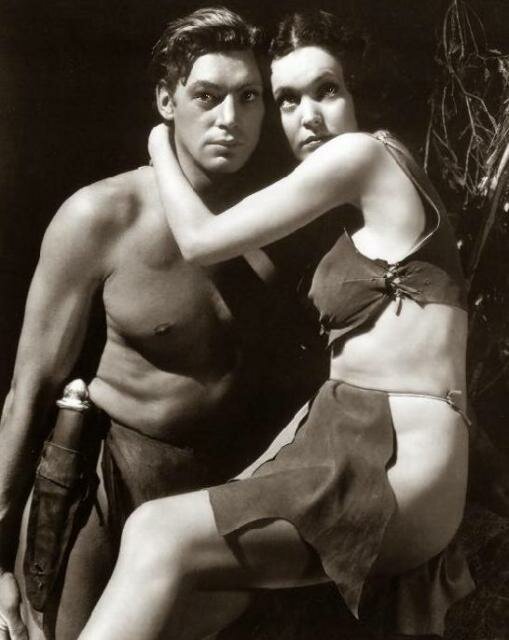You are hereMovie & TV Reviews / Action/Adventure
Action/Adventure
MOVIE & TV SERIES REVIEWS
By TOM SOTER from VIDEO MAGAZINE, 1991-1996  THE TARZAN COLLECTION 1993 comp. B&W. Tarzan Escapes (1936), Tarzan Finds A Son (1939), Tarzan's Secret Treasure (1941), Tarzan's New York Adventure (1942). Johnny Weissmuller, Maureen O'Sullivan, John Sheffield, Barry Fitzgerald, Cheetah; dir. Richard Thorpe. Digital mono. (NR) 420 min. CLV. 8 sides. $99.98. MGM/UA.
THE TARZAN COLLECTION 1993 comp. B&W. Tarzan Escapes (1936), Tarzan Finds A Son (1939), Tarzan's Secret Treasure (1941), Tarzan's New York Adventure (1942). Johnny Weissmuller, Maureen O'Sullivan, John Sheffield, Barry Fitzgerald, Cheetah; dir. Richard Thorpe. Digital mono. (NR) 420 min. CLV. 8 sides. $99.98. MGM/UA.
Edgar Rice Burroughs, the ex-pencil-sharpener salesman who created Tarzan of the Apes, knew his idea of a noble wild man living in a jungle paradise was hokum – "[An apeman] would probably have B.O., Halitosis, and Athlete's Foot, plus a most abominable disposition" – but Tarzan, Lord of the Jungle, struck a public chord, appearing in countless comic strips, radio shows, plays, and the world's longest-running movie series.
The best known actor in the role, Olympic athlete Johnny Weissmuller, played Tarzan for 17 years, and is featured here in four of his six MGM adventures. Although the simple-minded stories make ERB's sophisticated jungle man into a primitive boy toy, a hunk with no brains ("Me Tarzan") but a lot of brawn, the sexy, tawny Weismuller's appeal is obvious: after all, who could resist a guy that wrestles lions before breakfast, outswims alligators after lunch, and then rides elephants into the sunset? The high-budget formula films, which re-use plot elements and stock footage shamelessly, all involve white explorers intruding on Tarzan's jungle heaven in search of hidden treasure. At the climax of each, the apeman arrives with a flock of elephants to save spouse Jane from torture by savages.
The best of the lot is Tarzan's New York Adventure, which cleverly inverts the formula by having the apeman play intruder in New York City ("stone jungle"). Before the story ends, Tarzan has made monkeys out of cops and robbers alike, leaping across city rooftops and off the Brooklyn Bridge with a breathtaking, Olympian ease. There are also wry moments of social commentary (Tarzan on a night club: "Smell like Swahili swamp. Why men stay here?" Jane: "It's called having a good time"), amusing antics by Cheetah, and, of course, the elephants stampede in the end. 1993
CAPTAIN BLOOD 1935. Errol Flynn, Olivia de Havilland, Lionel Atwill, Basil Rathbone; dir. Michael Curtiz. Digital sound, 119 min. CLV, 2 sides; CAV, 1 side. MGM/UA.
1935. Errol Flynn, Olivia de Havilland, Lionel Atwill, Basil Rathbone; dir. Michael Curtiz. Digital sound, 119 min. CLV, 2 sides; CAV, 1 side. MGM/UA.
Errol Flynn made his dashing debut in this swashbuckling, silly epic, the first of many pairings with lovely Olivia de Havilland. As the energetic Dr. Peter Blood, he is convicted of a crime he didn't commit, and soon becomes a kind of Robin Hood of the Seven Seas, robbing from the British oppressors and doling out the proceeds to the poor (his men).
The plot – a Depression-era gangster movie in pirate garb – isn't much, but the daring-do is fine, a prototype for The Adventures of Robin Hood (1938), in which Flynn, de Havilland, and director Curtiz went through the same paces to much better effect. The best moments come from Basil Rathbone, who gives a delightfully hammy performance as a lecherous French swordsman who (naturally) has a duel with Flynn on the shores of a remote island. In real life, Rathbone was actually the better swordsman, but in a movie with a hero named Captain Blood, guess who wins? VIDEO, November 1992
[[wysiwyg_imageupload:1355:]]
